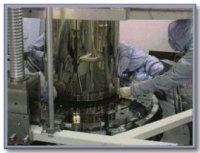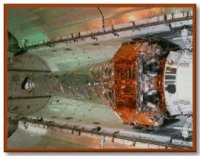Tuesday March 6, 2001
13:00 Eastern
| "CHANDRA"--MAN, MISSION, TELESCOPE AND TECHNOLOGY |
Martin Weisskopf, Chandra Project Scientist, NASA MSFC |
|
Chandra himself, with the equation showing white dwarfs could not be greater than 3 solar masses |
But everything we’ve seen in this program would have been impossible without the ingenuity of the men and women who built and operate CHANDRA and other great observatories such as the Hubble Space Telescope. This section goes behind the press releases and the pretty pictures to show the technology which makes discovery possible. We trace how X-ray astronomy grew from simple instruments aboard short-lived rocket flights to today’s sophisticated CHANDRA telescope. |
|
Harvey Tananbaum talks about the early "Uhuru" satellite, launched from a sea-based platform off the coast of Kenya on the 7th anniversary of that nation’s Independence Day. It soon discovered an x-ray source, Cygnus X-1, which was the first evidence of an actual black hole. Marty Weisskopf, CHANDRA Project Scientist from NASA’s Marshall Space Flight Center, compares CHANDRA’s resolution to what came before. |
|
|
|
Steve Murray dons a "bunny suit" to describe why it takes super clean rooms to build the instruments that will be CHANDRA’s eyes and brains, and Kathy Flanagan helps us understand how this telescope puts the laws of physics and chemistry and engineering together in a rugged, orbit-bound package of spacecraft systems destined to operate for at least 5 more years. |



